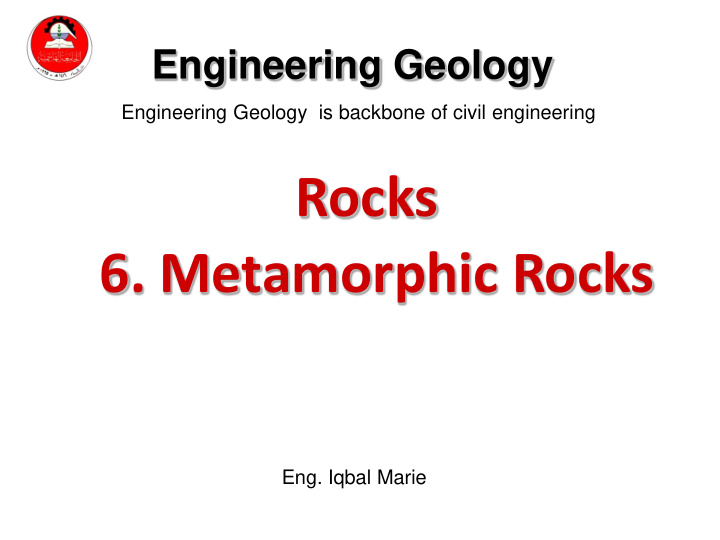



Engineering Geology Engineering Geology is backbone of civil engineering Rocks 6. Metamorphic Rocks Eng. Iqbal Marie
Metamorphism occurs when any previously existing rock, the parent rock ( protolith ) , is buried in the earth under layers of other rock, at high temperature and pressure to produce changes in texture and crystallization. Metamorphic rock looks quite different from the original rock. Metamorphic textures and minerals are most likely formed over 10 to 20 million years or longer Metamorphic rocks are produced from – Igneous rocks – Sedimentary rocks – Other metamorphic rocks In most cases, the overall chemistry of the metamorphic rock is very similar to that of the parent rock
Metamorphic Environments There are three types of metamorphism • Contact • Regional • Dynamic • Contact or thermal metamorphism • Result from a rise in temperature when magma invades a host rock. Occurs at high temperature and (typically) low pressure. Normally affects a small area .
• Regional metamorphism • Affects a large area and produces the greatest quantity of metamorphic rock. Associated with mountain building • High temperature, high pressure and shear stress. Fault zone metamorphic rocks are formed as a consequence of changes that happens along fault lines within the Earth's crust.
• Hydrothermal metamorphism • Chemical alteration caused when hot, ion-rich fluids, called hydrothermal solutions, circulate through fissures and cracks that develop in rock
Factors Controlling Metamorphism • Heat • Most important agent • Two sources of heat – Contact metamorphism – heat from magma – An increase in temperature with depth due to the geothermal gradient 15-30 o C increase per km • Pressure and differential stress • Confining pressure applies forces equally in all directions; increases with depth • Rocks may also be subjected to differential stress which is unequal in different directions • Chemically active fluids • Mainly water with other volatile components • Aids in re-crystallization of existing minerals • Sources of fluids – Pore spaces of sedimentary rocks – Fractures in igneous rocks – Hydrated minerals such as clays and micas
If the same protoliths experience different conditions of temperature and pressure, they will yield different metamorphic rocks Pressure Heat Basalt Eclogite Greenschist
Metamorphic Grade : intensity of Metamorphism Metamorphism ends when melting begins Melting begins at ~700 o C High-grade (extreme) metamorphism: radical changes in texture and/or mineral composition of the rock High above 550 O C Low Low-grade (mild) metamorphism: small changes Intermediate in texture and/or mineralogy of parent rock ( 200 to 350 O C ) 350 to 550 O C
CHANGES DURING METAMORPHISM? • Rock texture changes • Foliation: Parallel alignment of platy or elongate mineral grains (mica/amphibole) in a rock caused by directed stress. – slaty cleavage: parallel alignment of microscopic platy minerals (mainly mica). LOW-GRADE METAMORPHISM – phyllitic texture: parallel, but wavy, foliation of fine-grained platy minerals (mainly mica and chlorite) exhibiting a shiny or glossy luster. LOW-GRADE METAMORPHISM – schistosity: parallel to sub-parallel foliation of medium to coarse-grained platy minerals. INTERMEDIATE TO HIGHGRADE METAMORPHISM – gneissic layering: discontinuous light and dark layering due to mineral segregation. INTERMEDIATE TO HIGH-GRADE METAMORPHISM • Mineralogy changes – New minerals form that are stable under the new metamorphic conditions
Foliation. Due to compressive stress and differential stress and/or shearing forces the mineral grains in a metamorphic rock form parallel layers or bands. New metamorphic minerals crystallize along this foliation Foliation usually formed planes of weakness in metamorphic rock because the rock can be easily break along the foliation planes.
Kinds of foliation Slaty cleavage Schistosity Gneissic banding
Some main points about metamorphic rocks - The rocks which do not have planar patterns of strain or stretching are termed as non-foliated metamorphic rocks. These rocks are most often deduced from single mineral sedimentary rocks. - High temperature and pressure erases out the fossils of the metamorphic rocks. - Metamorphic rocks do not have pores or openings, and may be accompanied with visible layers of crystals.
Common metamorphic rocks Foliated Metamorphic Rocks (Regional Metamorphism) • Gneiss – highest grade of metamorphism, coarse grained; generally banded (segregation bands of light and dark- coloured minerals); • Schist – medium grade of metamorphism; sand size, schistocity cleavage. • Phyllite – low grade of metamorphism; fine grained (silt-sized); • Slate – lowest grade of metamorphism; very fine-grained; mud-sized; smooth surface. Phyllite
slate Schist Gneiss shale
GNEISS Medium- to coarse-grained Often composed of white or light- colored feldspar-rich layers with bands of dark ferromagnesian minerals
Non-Foliated Metamorphic Rocks (Contact/Thermal Metamorphism) • Granulite (granite / acid igneous rocks origin) • Amphibolite (basic igneous rocks origin)- basalt ( Amphipole ) • Quarzite (sandstone origin) • Marble (limestone origin) • Hornfels (mudstone/shale origin)
Recrystallization – minerals grow and develop an interlocking texture Marble : Coarse, crystalline Quartzite • Parent rock was limestone or dolostone Formed from a parent rock of • Used as a decorative and monument stone quartz-rich sandstone Quartz • grains are fused together Exhibits a variety of colors
Importance of Metamorphism valuable mineral and rock resources A. Building material: – Marble which is used for ornamental building stone. – Slate which is used for roofing, flooring, billiard/pool tables, and blackboards B. Economic metamorphic minerals include: – Graphite used in pencils and lubricants. – Garnet and Corundum used as gemstones and abrasives. – Asbestos formerly used as a heat insulator. – Kyanite, Andalusite, Sillimanite (aluminum silicates) are used a raw material in the ceramics industry. C. Ore Deposits - result from contact metamorphism where hydrothermal solutions precipitate ore minerals in surrounding rocks: – Iron and Tin Oxides deposits (hematite, magnetite, and cassiterite) – Precious metal deposits (gold)
Recommend
More recommend